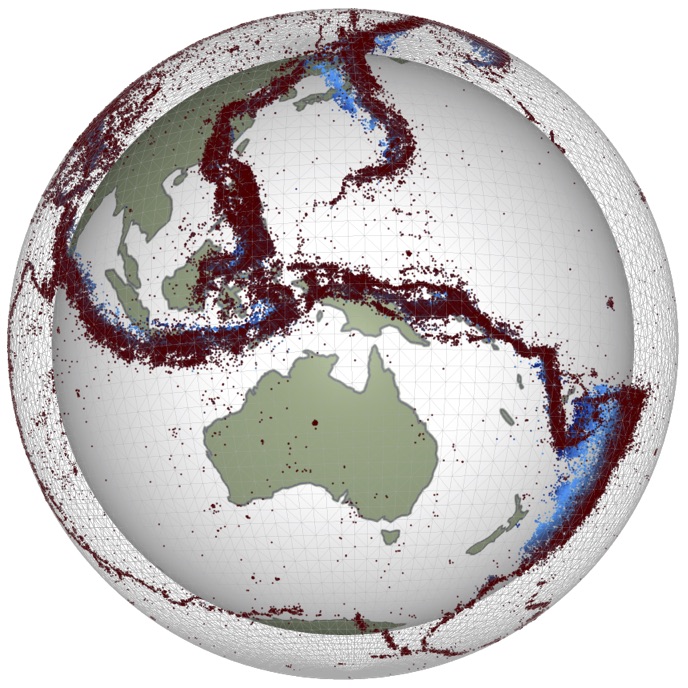Underworld Groundwater Flow Benchmark 1#
See the Underworld2 example by Adam Beall.
Flow driven by gravity and topography. We check the flow for constant permeability and for exponentially decreasing permeability as a function of depth.
Note, this benchmark is a bit problematic because the surface shape is not really consistent with the sidewall boundary conditions - zero gradients at the vertical boundaries.If we replace the sin(x) term with cos(x) to describe the surface then it works a little better because there is no kink in the surface topography at the walls.
Note, there is not an obvious way in pyvista to make the streamlines smaller / shorter / fainter where flow rates are very low so the visualisation is a little misleading right now.
# to fix trame issue
import nest_asyncio
nest_asyncio.apply()
# %%
from petsc4py import PETSc
import underworld3 as uw
import numpy as np
import sympy
options = PETSc.Options()
# %%
mesh = uw.meshing.UnstructuredSimplexBox(
minCoords=(0.0, 0.0), maxCoords=(4.0, 1.0), cellSize=0.05, qdegree=3
)
p_soln = uw.discretisation.MeshVariable("P", mesh, 1, degree=2)
v_soln = uw.discretisation.MeshVariable("U", mesh, mesh.dim, degree=1, continuous=False)
Mesh deformation
x, y = mesh.X
h_fn = 1.0 + x * 0.2 / 4 + 0.04 * sympy.cos(2.0 * np.pi * x) * y
new_coords = mesh.data.copy()
new_coords[:, 1] = uw.function.evaluate(h_fn * y, mesh.data, mesh.N)
mesh.deform_mesh(new_coords=new_coords)
# %%
if uw.mpi.size == 1 and uw.is_notebook:
import pyvista as pv
import underworld3.visualisation as vis
pvmesh = vis.mesh_to_pv_mesh(mesh)
pl = pv.Plotter(window_size=(750, 750))
pl.add_mesh(
pvmesh,
cmap="coolwarm",
edge_color="Black",
show_edges=True,
use_transparency=False,
)
pl.show(cpos="xy")
# %%
# Create Poisson object
darcy = uw.systems.SteadyStateDarcy(mesh, h_Field=p_soln, v_Field=v_soln)
darcy.constitutive_model = uw.constitutive_models.DarcyFlowModel
darcy.constitutive_model.Parameters.permeability = 1
darcy.petsc_options.delValue("ksp_monitor")
Set some things
k = sympy.exp(-2.0 * 2.302585 * (h_fn - y)) # powers of 10
darcy.constitutive_model.Parameters.permeability = k
k
darcy.f = 0.0
darcy.constitutive_model.Parameters.s = sympy.Matrix([0, -1]).T
darcy.add_dirichlet_bc(0.0, "Top")
Zero pressure gradient at sides / base (implied bc)
darcy._v_projector.smoothing = 0.0
# %%
# Solve time
darcy.petsc_options.setValue("snes_monitor", None)
darcy.solve(verbose=False)
# %%
if uw.mpi.size == 1 and uw.is_notebook:
import pyvista as pv
import underworld3.visualisation as vis
pvmesh = vis.mesh_to_pv_mesh(mesh)
pvmesh.point_data["V"] = vis.vector_fn_to_pv_points(pvmesh, v_soln.sym)
pvmesh.point_data["P"] = vis.scalar_fn_to_pv_points(pvmesh, p_soln.sym)
pvmesh.point_data["dP"] = vis.scalar_fn_to_pv_points(pvmesh, p_soln.sym[0] - (h_fn - y))
pvmesh.point_data["K"] = vis.scalar_fn_to_pv_points(pvmesh, k)
pvmesh.point_data["S"] = vis.scalar_fn_to_pv_points(pvmesh, sympy.log(v_soln.sym.dot(v_soln.sym)))
velocity_points = vis.meshVariable_to_pv_cloud(v_soln)
velocity_points.point_data["V"] = vis.vector_fn_to_pv_points(velocity_points, v_soln.sym)
# point sources at cell centres
points = np.zeros((mesh._centroids.shape[0], 3))
points[:, 0] = mesh._centroids[:, 0]
points[:, 1] = mesh._centroids[:, 1]
point_cloud = pv.PolyData(points[::3])
pvstream = pvmesh.streamlines_from_source(
point_cloud,
vectors="V",
integrator_type=45,
integration_direction="both",
max_steps=1000,
max_time=0.2,
initial_step_length=0.001,
max_step_length=0.01,
)
pl = pv.Plotter()
pl.add_mesh(
pvmesh,
cmap="coolwarm",
edge_color="Black",
show_edges=True,
scalars="P",
use_transparency=False,
opacity=1.0,
)
pl.add_arrows(velocity_points.points, velocity_points.point_data["V"], mag=0.5, opacity=0.5)
pl.add_mesh(pvstream, line_width=1.0)
pl.show(cpos="xy")
Metrics#
_, _, _, max_p, _, _, _ = p_soln.stats()
print("Max pressure : {:4f}".format(max_p))

